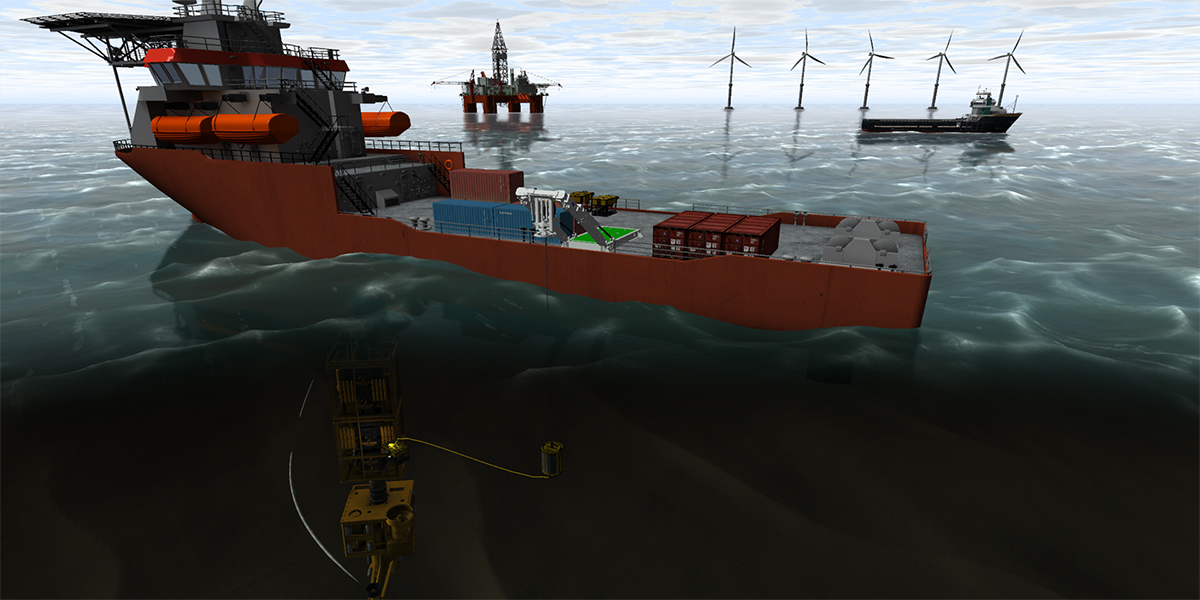Choosing the right technology partner for simulating offshore operations

The use of simulation technology is nothing new for the offshore industry. What’s changed is how advanced the technology has become. This can make choosing a simulator technology partner something of a challenge. Make sure you ask for a maintainable and accessible system to maximise your return on investment and to ensure a futureproof solution for your business.
Many companies looking to update their existing simulators can often be surprised by the great visual quality and realistic style now possible. At the same time, this shouldn’t distract you from carrying out a critical analysis of what’s under the hood to better understand how simulation technology should support your operational objectives.
In this blog post, we explore what companies in the offshore industry need to look for when searching for the right simulator technology partner.
Impressive visuals & accurate physics
Due to developments in the entertainment industry, particularly gaming, most people are aware of the potential of modern technology to create realistic and immersive environments. The same is true for simulators intended for use in offshore industries. One of the most impressive things about modern simulation technology is its ability to accurately mimic the real-world laws of physics. In the past, simulators were more schematic. They might have been able to let objects move in a specific time or space, but they lacked the ability to simulate life-like cause and effect.
Everyday computer hardware can now handle more sophisticated visuals together with accurate physics. This combination means that it’s possible to create highly-realistic representations of real-world machinery based on actual data – digital twins – and put them to work in virtual environments which replicate real-world conditions related to any offshore or subsea operation. For both testing and training purposes, being able to simulate the performance of expensive offshore equipment in different conditions is hugely beneficial.
Close to the real thing
For training and testing purposes, realistic and immersive visuals paired with the laws of physics help to create an accurate and trustworthy picture of how offshore equipment will perform in the real world. Simulations can be run at every stage of the process – from before the machinery even exists to when it’s deployed on site.
However, what makes it truly valuable is when the simulator can be connected to physical control devices. Connecting real controls to a virtual environment provides the ultimate playground for both training new operators and testing out potential applications. This saves both time and money, protecting real equipment from damage, avoiding downtime due to training, and ensuring that work can be carried out safely before it proceeds.
For example, with a simulated robotic arm, it’s now possible to zoom in and actually see the materials bend in response to a particular force. At the same time, different variables can easily be adapted for testing purposes. So during engineering, it’s feasible to test out components made from different types of material in just a few clicks, long before any ‘’wet testing’’. The same applies to changes to its control software, those can be validated in VR instead of exposing the robot arm to potential damage during testing.
A well-designed simulator that already proved its value during engineering is easily turned into a training simulator, to bring safety and efficiency to the operational stages to follow. Dedicated features like generating random events or calamities and automated assessment will complete a powerful training tool, as close to the real thing you can get.
Wider area of application
For companies working in the offshore industry, it goes without saying that it’s common to use software to visualise the design of a new piece of machinery in a static environment. Also training on simulators is now becoming common practice.
What’s not always as well-known is that simulation software can use the data from designs to create a fully-working, digital version of the equipment. It’s here that the offshore industries have a real opportunity to harness the potential of simulator technology at the engineering phase – and use it to its full potential through the complete equipment lifecycle.
The right partner
This calls for a technology partner that is not only capable of providing the technical state-of-art in simulation, but also has the expertise to develop a well-structured multipurpose simulator application. Such systems should be designed to be maintainable and extendable with new 3D content and new functionalities, meeting the specific demands of the stage in the equipment lifecycle.
Instead of ordering a single purpose ‘’black box’’, you would want your engineers to be able to tune and configure the simulator to their needs and your trainers to configure any specific scenario that needs preparation and rehearsal. A multi-purpose open and flexible simulator framework is the answer, ready to load any type of virtual equipment. To be supported by a ‘’team behind the application’’, that will provide you the necessary training and handholding.
With offshore equipment simulated in this way, it’s possible to really cut costs by tackling engineering challenges before building numerous expensive prototypes or exposing expensive equipment to unnecessary risk. For that reason, there’s a place for simulation software throughout the entire process, creating value from initial design right through to operator training and mission preparation.